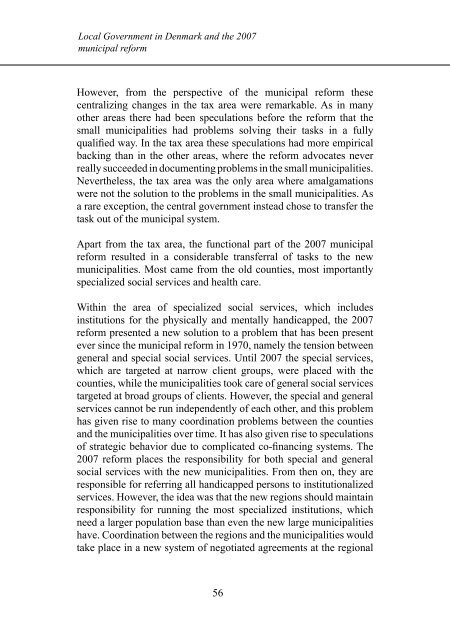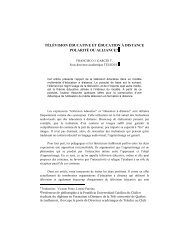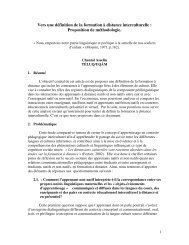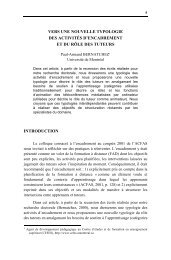61 Rethinking local government: Essays on municipal reform - VATT
61 Rethinking local government: Essays on municipal reform - VATT
61 Rethinking local government: Essays on municipal reform - VATT
Create successful ePaper yourself
Turn your PDF publications into a flip-book with our unique Google optimized e-Paper software.
Local Government in Denmark and the 2007<strong>municipal</strong> <strong>reform</strong>However, from the perspective of the <strong>municipal</strong> <strong>reform</strong> thesecentralizing changes in the tax area were remarkable. As in manyother areas there had been speculati<strong>on</strong>s before the <strong>reform</strong> that thesmall <strong>municipal</strong>ities had problems solving their tasks in a fullyqualified way. In the tax area these speculati<strong>on</strong>s had more empiricalbacking than in the other areas, where the <strong>reform</strong> advocates neverreally succeeded in documenting problems in the small <strong>municipal</strong>ities.Nevertheless, the tax area was the <strong>on</strong>ly area where amalgamati<strong>on</strong>swere not the soluti<strong>on</strong> to the problems in the small <strong>municipal</strong>ities. Asa rare excepti<strong>on</strong>, the central <str<strong>on</strong>g>government</str<strong>on</strong>g> instead chose to transfer thetask out of the <strong>municipal</strong> system.Apart from the tax area, the functi<strong>on</strong>al part of the 2007 <strong>municipal</strong><strong>reform</strong> resulted in a c<strong>on</strong>siderable transferral of tasks to the new<strong>municipal</strong>ities. Most came from the old counties, most importantlyspecialized social services and health care.Within the area of specialized social services, which includesinstituti<strong>on</strong>s for the physically and mentally handicapped, the 2007<strong>reform</strong> presented a new soluti<strong>on</strong> to a problem that has been presentever since the <strong>municipal</strong> <strong>reform</strong> in 1970, namely the tensi<strong>on</strong> betweengeneral and special social services. Until 2007 the special services,which are targeted at narrow client groups, were placed with thecounties, while the <strong>municipal</strong>ities took care of general social servicestargeted at broad groups of clients. However, the special and generalservices cannot be run independently of each other, and this problemhas given rise to many coordinati<strong>on</strong> problems between the countiesand the <strong>municipal</strong>ities over time. It has also given rise to speculati<strong>on</strong>sof strategic behavior due to complicated co-financing systems. The2007 <strong>reform</strong> places the resp<strong>on</strong>sibility for both special and generalsocial services with the new <strong>municipal</strong>ities. From then <strong>on</strong>, they areresp<strong>on</strong>sible for referring all handicapped pers<strong>on</strong>s to instituti<strong>on</strong>alizedservices. However, the idea was that the new regi<strong>on</strong>s should maintainresp<strong>on</strong>sibility for running the most specialized instituti<strong>on</strong>s, whichneed a larger populati<strong>on</strong> base than even the new large <strong>municipal</strong>itieshave. Coordinati<strong>on</strong> between the regi<strong>on</strong>s and the <strong>municipal</strong>ities wouldtake place in a new system of negotiated agreements at the regi<strong>on</strong>al56
















